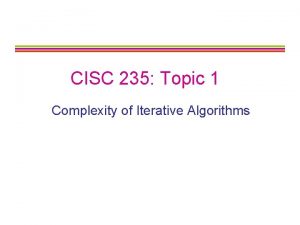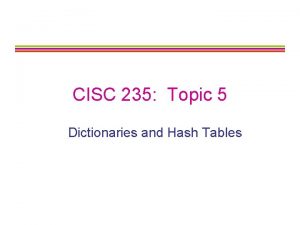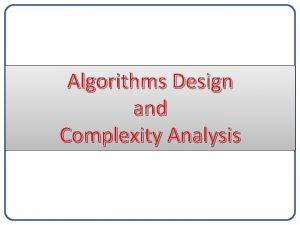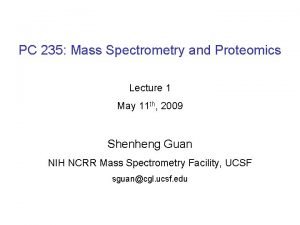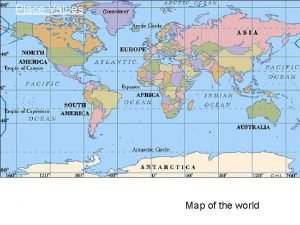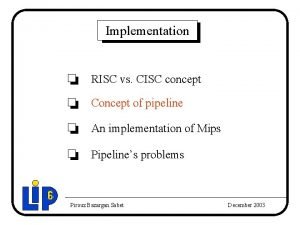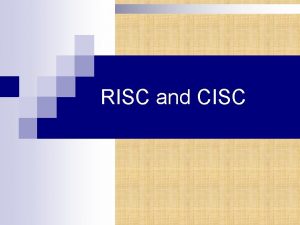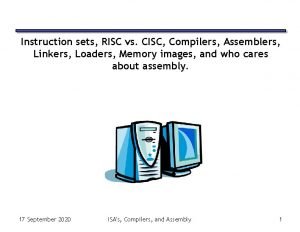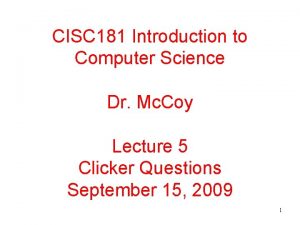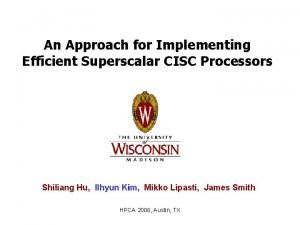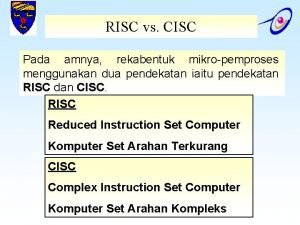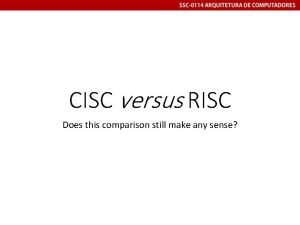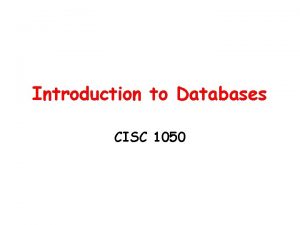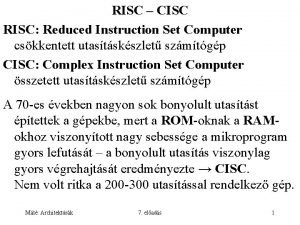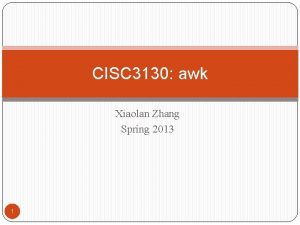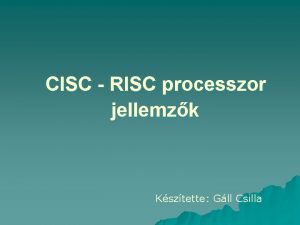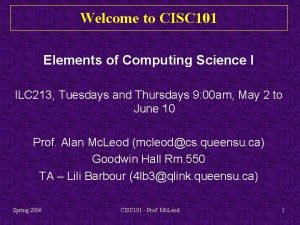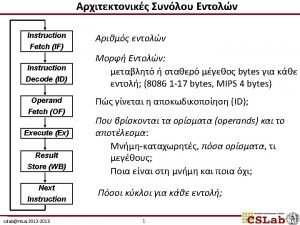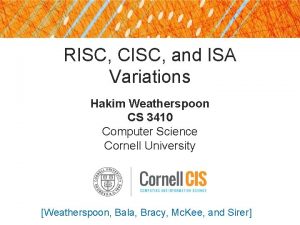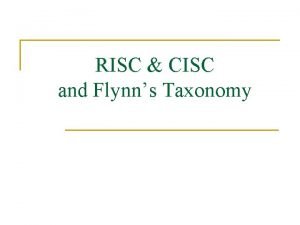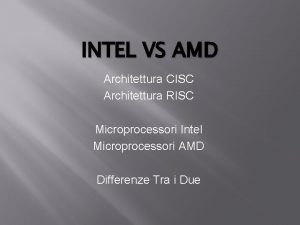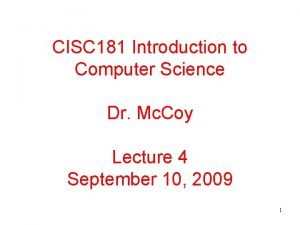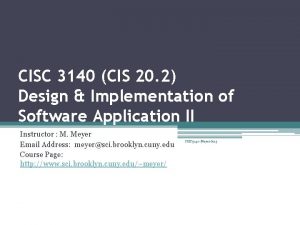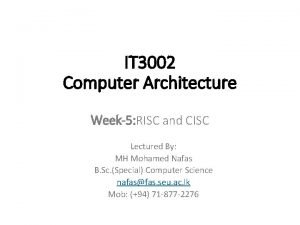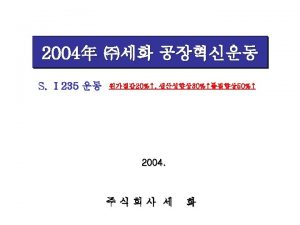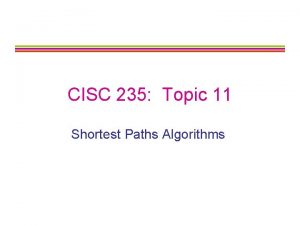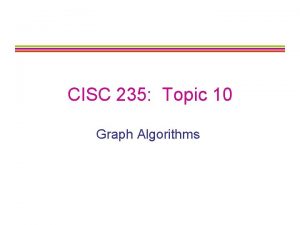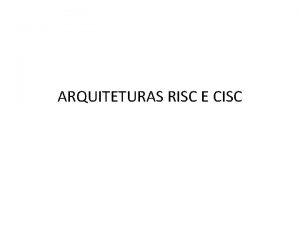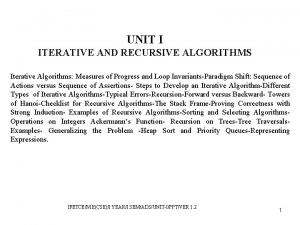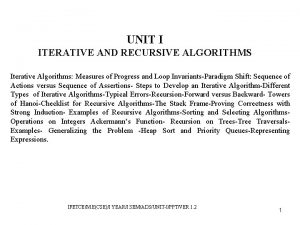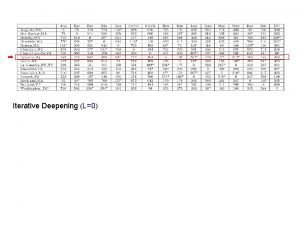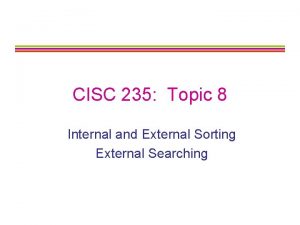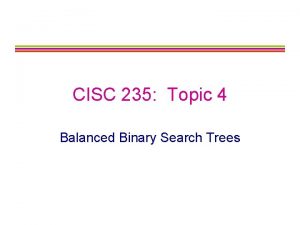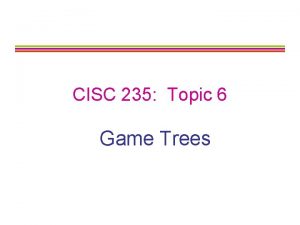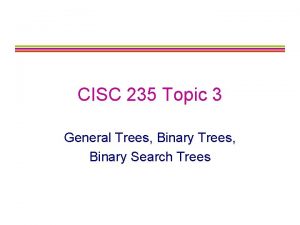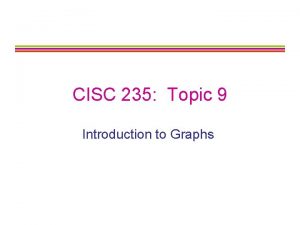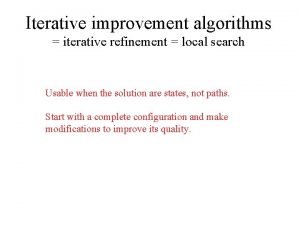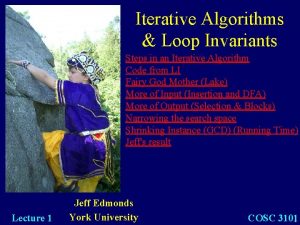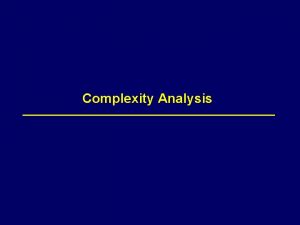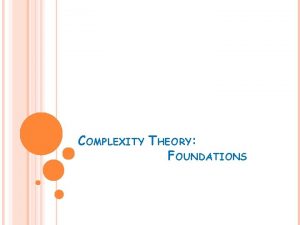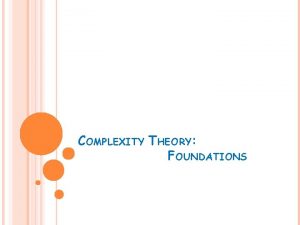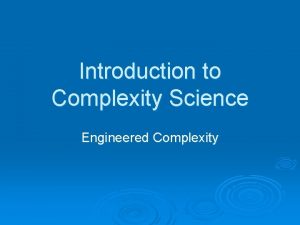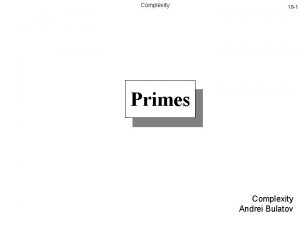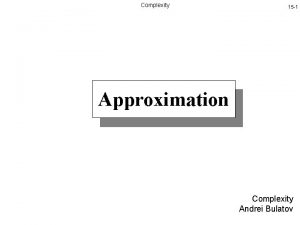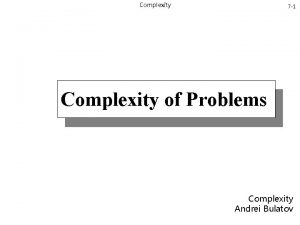CISC 235 Topic 1 Complexity of Iterative Algorithms
























![Algorithm 1 p. Val = A[0] for (int i = 1; i <= n; Algorithm 1 p. Val = A[0] for (int i = 1; i <= n;](https://slidetodoc.com/presentation_image/efdae6420a9291dd8ebc9e2a5fd8b524/image-25.jpg)
![Algorithm 2 p. Val = A[0] for ( int i = 1; i <= Algorithm 2 p. Val = A[0] for ( int i = 1; i <=](https://slidetodoc.com/presentation_image/efdae6420a9291dd8ebc9e2a5fd8b524/image-26.jpg)











- Slides: 37

CISC 235: Topic 1 Complexity of Iterative Algorithms

Outline • • • Complexity Basics Big-Oh Notation Big-Ω and Big-θ Notation Summations Limitations of Big-Oh Analysis CISC 235 Topic 1 2

Complexity is the study of how the time and space to execute an algorithm vary with problem size. The purpose is to compare alternative algorithms to solve a problem to determine which is “best”. Time Complexity: Let T(n) denote the time to execute an algorithm with input size n How can we measure T(n)? CISC 235 Topic 1 3

Experimental Study Implement the alternative algorithms and then time them with various benchmarks, measuring running time with a method like Java’s System. current. Time. Millis( ) T(n) Too much coding & not general results CISC 235 Topic 1 n 4

Mathematical Analysis Analyze alternative algorithms mathematically prior to coding – Define the amount of time taken by an algorithm to be a function of the size of the input data: T(n) = ? – Count the key instructions that are executed to obtain the value of the function in terms of the size of the input data – Compare algorithms by comparing how fast their running time functions grow as the input size increases CISC 235 Topic 1 5

Finding an Algorithm’s Running Time Function Count the key instructions that are executed to obtain the running time in terms of the size of the input data. Important Decisions: • What is the measure of the size of input? • Which are the key instructions? CISC 235 Topic 1 6

Example: Find smallest value in array A of length n int small = 0; for ( int j = 0; j < n; j++ ) if ( A[j] < A[small] ) small = j; Counting Assignments: Line 1: 1 Line 2: n + 1 Line 3: 0 Line 4: best case: 0 worst case: n So, T(n) = 2 n + 2 CISC 235 Topic 1 7

Example: Find smallest value in array A of length n int small = 0; for ( int j = 0; j < n; j++ ) if ( A[j] < A[small] ) small = j; Substitute constants a & b to reduce analysis time: Line 1: b (constant time for everything outside loop) Line 2: n (variable number of times through loop) Lines 2, 3, 4: a (constant time for everything inside loop, including loop test & increment) So, T(n) = an + b CISC 235 Topic 1 8

For large input sizes, constant terms are insignificant Program A with running time TA(n)= 100 n Program B with running time TB(n)= 2 n 2 TP(n) TB(n) = 2 n 2 TA(n) = 100 n 5000 CISC 235 Topic 1 50 Input Size n 9

Big-Oh Notation Purpose: Establish a relative ordering among functions by comparing their relative rates of growth Example: f(x) = 4 x + 3 Big-Oh Notation: f(x) O(x) or f(x) is O(x) CISC 235 Topic 1 10

Definition of Big-Oh Notation f(x) is O(g(x)) if two constants C and k can be found such that: for all x k, f(x) ≤ Cg(x) Note: Big-Oh is an upper bound CISC 235 Topic 1 11

Meaning of Big-Oh Notation • The function f(x) is one of the set of functions that has an order of magnitude growth rate ≤ the growth rate of g(x) OR • f(x) is at most a constant times g(x), except possibly for some small values of x CISC 235 Topic 1 12

Graph of Big-Oh for a Program T(n) Running Cg(n) For all n k, T(n) ≤ Cg(n) Time T(n) g(n) K or CISC 235 Topic 1 K or … Input Size n 13

Show that 03 -2 -001. jpg f(x) = x 2 + 2 x + 1 is O(x 2) So, we can take k = 1 and C = 4 to show that f(x) = x 2 + 2 x + 1 is O(x 2) If x > 1, then x 2 + 2 x + 1 x 2 + 2 x 2 + x 2 = 4 x 2 If x > 2, then x 2 + 2 x + 1 x 2 + x 2 = 3 x 2 CISC 235 Topic 1 14

Rules for Big-Oh • We want to find the closest upper bound – if f(x) = 100 x, we choose f(x) is O(x), not f(x) is O(x 2) • Never include constants or lower-order terms within a Big-Oh (so also don’t include the base of a logarithm) – if f(x) = 2 x 2 + x we choose f(x) is O(x 2), not f(x) is O(2 x 2) and not f(x) is O(x 2 + x) CISC 235 Topic 1 15

Order of Magnitude Growth Rates Function Descriptor Big-Oh C Constant O( 1 ) log n Logarithmic O( log n ) n Linear O( n ) n log n O( n log n ) n 2 Quadratic O( n 2 ) n 3 Cubic O( n 3 ) nk Polynomial O( nk ) 2 n Exponential O( 2 n ) n! Factorial O( n! ) CISC 235 Topic 1 16

03 -2 -003. jpg CISC 235 Topic 1 Order of Magnitude Growth Rates 17

Change to Running Times When Input Size n is Doubled? Function C log n n n 2 n 3 2 n n = 100 C ~5 1002 1003 ~10015 n = 200 C + ____ ~5 + ____ 100 * ____ 1002 * ____ 1003 * ____ ~10015 * ____ CISC 235 Topic 1 Change 18

Growth of Combinations of Functions If f 1(x) is O( g 1(x) ) and f 2(x) is O( g 2(x) ), Then (f 1 + f 2)(x) is O( max( g 1(x), g 2(x) )) and (f 1 f 2)(x) is O( g 1(x)g 2(x) ) CISC 235 Topic 1 19

Deriving Big-Oh of Functions f( x ) Big-Oh 3 x 2 + 5 O(x 2 ) 2 x 3 - x 2 - 6 O(x 3 ) log 2 x + x O(x ) (5 + log 2 x)(3 x - 3) O(xlogx ) 4( 2 x - x 3 ) O(2 x ) 4 c - 6 d + 17 a O( 1 ) CISC 235 Topic 1 20

Big-Omega (Big-Ω) Notation Expresses a lower-bound of a function f(x) is Ω(g(x)) if f(x) is at least a constant times g(x), except possibly for some small values of x. Formally: f(x) is Ω(g(x)) if two constants C and k can be found such that for all x k, f(x) ≥ Cg(x) CISC 235 Topic 1 21

Graph of Big-Ω for a Program T(n) Running T(n) For all n k, T(n) ≥ Cg(n) Time Cg(n) K CISC 235 Topic 1 Input Size n 22

Big-Theta (Big- ) Notation Expresses a tight bound of a function f(x) is (g(x)) if f(x) is both O(g(x)) and Ω(g(x)) C 1 g(n) T(n) CISC 235 Topic 1 Input Size n C 2 g(n) 23

Example Input: An n+1 element array A of coefficients and x, a number Output: p. Val, the value of the polynomial A[0] + A[1]x + A[2]x 2 +… + A[n]xn CISC 235 Topic 1 24
![Algorithm 1 p Val A0 for int i 1 i n Algorithm 1 p. Val = A[0] for (int i = 1; i <= n;](https://slidetodoc.com/presentation_image/efdae6420a9291dd8ebc9e2a5fd8b524/image-25.jpg)
Algorithm 1 p. Val = A[0] for (int i = 1; i <= n; i++) p. Val = p. Val + A[i] * Math. pow(x, i); What is the Big-Oh analysis of this algorithm? CISC 235 Topic 1 25
![Algorithm 2 p Val A0 for int i 1 i Algorithm 2 p. Val = A[0] for ( int i = 1; i <=](https://slidetodoc.com/presentation_image/efdae6420a9291dd8ebc9e2a5fd8b524/image-26.jpg)
Algorithm 2 p. Val = A[0] for ( int i = 1; i <= n; i++ ) { pow. X = 1 for ( int j = 0; j < i; j++ ) pow. X = x * pow. X p. Val = p. Val + A[i] * pow. X } What is the Big-Oh analysis of this algorithm? CISC 235 Topic 1 26

Algorithm 3 Horner’s method: To evaluate a 0 + a 1 x + a 2 x 2 + … + anxn, use: P(x) = a 0 + (x (a 1 + x(a 2 + … + x(an-1 + xan) …))) p. Val = x * A[n] for (int i = n -1; i > 0; i - -) p. Val = x * ( A[i] + p. Val ) p. Val = p. Val + A[0] What is the Big-Oh analysis of this algorithm? CISC 235 Topic 1 27

Example: Selection Sort for ( int i = 0; i < n-1; i++ ) { int small = i; for ( int j = i + 1; j < n; j++ ) if ( A[j] < A[small] ) small = j; int temp = A[small]; A[small] = A[i]; A[i] = temp; } CISC 235 Topic 1 28

Summation Notation n ∑ ai i=m Represents am + am+1 + … + an CISC 235 Topic 1 29

t 02 -4 -02. jpg CISC 235 Topic 1 30

Summation Manipulations 1. Take out constant terms: n n ∑ k/2 = ½ ∑ k k=1 2. Decompose large terms: n n ∑ n-k+k 2 = ∑ n – ∑ k + ∑ k 2 k=1 k=1 CISC 235 Topic 1 k=1 31

Summation Manipulations 3. Partial Sums: n ∑k n = k=j+1 j ∑k k=1 – ∑k k=1 4. Practice: n ∑ kj + a j=i = ____________ CISC 235 Topic 1 32

Number of Terms in a Summation Upper Bound – Lower Bound + 1 n ∑ 1 =1+1+…+1=n– 2+1=n– 1 k=2 n-1 ∑ 1 = 1 + … + 1 = (n– 1) – (j+1) + 1 k=j+1 =n–j– 1 Note: This is equivalent to calculating the number of iterations in a for loop CISC 235 Topic 1 33

Calculating Arithmetic Summations ((First Term + Last Term) * Number of Terms) / 2 n ∑k = 1 + 2 + … + n = (1+n) * n/2 = n(n+1) k=1 n-2 ∑ n–i– 1 i=0 2 = (n– 1) + (n– 2) + … + 1 = ((n-1) + 1) * (n-1)/2 = n( n-1) 2 CISC 235 Topic 1 34

Example: Max Subsequence Sum int max. Sum = 0; int besti = 0; int bestj = 0; for ( int i = 0; i < n; i++ ) for ( int j = i; j < n; j++ ) { int this. Sum = 0; for ( int k = i; k <= j; k++ ) this. Sum = this. Sum + A[k]; if ( this. Sum > max. Sum ) { max. Sum = this. Sum; besti = i; bestj = j; } } CISC 235 Topic 1 35

Analyzing Complexity of Lists Operation Sorted Array Sorted Linked List Unsorted Array Unsorted Linked List Search( L, x ) Insert( L, x ) Delete( L, x ) CISC 235 Topic 1 36

Limitations of Big-Oh Analysis • Not appropriate for small amounts of input – Use the simplest algorithm • Large constants can affect which algorithm is more efficient – e. g. , 2 nlogn versus 1000 n • Assumption that all basic operations take 1 time unit is faulty – e. g. , memory access versus disk access (1000 s of time more ) • Big-Oh can give serious over-estimate – e. g. , loop inside an if statement that seldom executes CISC 235 Topic 1 37
 Cisc 235
Cisc 235 Cisc 235
Cisc 235 Time complexity of algorithms
Time complexity of algorithms Time space complexity of algorithm
Time space complexity of algorithm Pc 235
Pc 235 Place value and
Place value and Add the place value of 3 in 235 to 150
Add the place value of 3 in 235 to 150 Cps 235
Cps 235 Geiger counter
Geiger counter Cas cs 235
Cas cs 235 Round off to the nearest ones place
Round off to the nearest ones place 234 235
234 235 Topic down
Topic down Third person example
Third person example Architettura cisc
Architettura cisc What is risc and cisc
What is risc and cisc Arquitectura risc y cisc
Arquitectura risc y cisc Cisc 181
Cisc 181 Cisc scalar processor
Cisc scalar processor Ciri ciri cisc
Ciri ciri cisc Cisc
Cisc Cisc 1050
Cisc 1050 Risc cisc architecture
Risc cisc architecture Cisc 3130
Cisc 3130 Risc, cisc
Risc, cisc Cisc 101
Cisc 101 Ciri ciri cisc
Ciri ciri cisc Arquitetura risc e cisc
Arquitetura risc e cisc Isa
Isa Risc and cisc difference
Risc and cisc difference Goetz 1003
Goetz 1003 Architettura cisc
Architettura cisc Alasan mengapa digunakan risc
Alasan mengapa digunakan risc Computer organisation and architecture
Computer organisation and architecture Cisc 181
Cisc 181 Cisc 3140
Cisc 3140 Cisc vs risc architecture
Cisc vs risc architecture Cisc cu boulder
Cisc cu boulder
